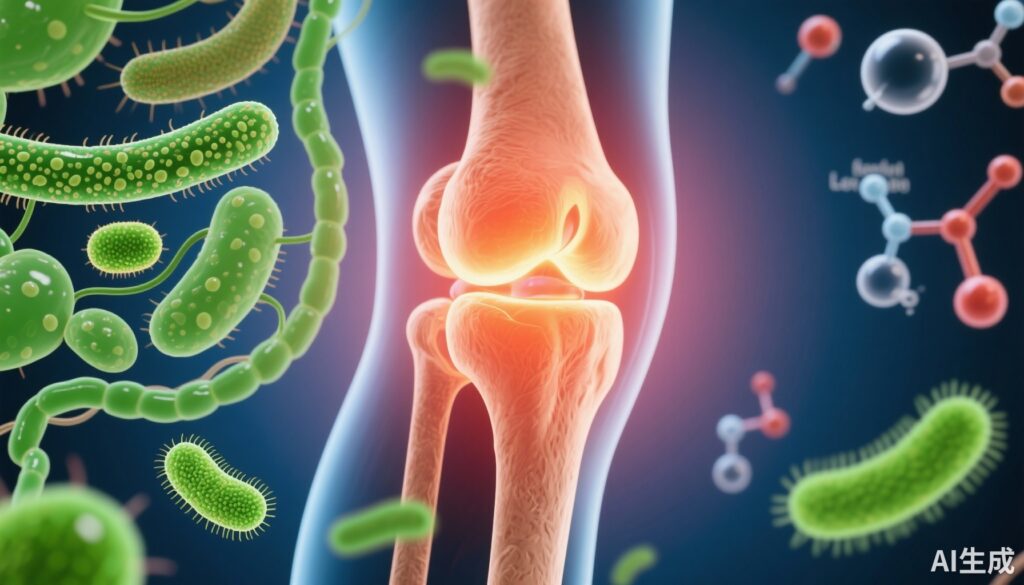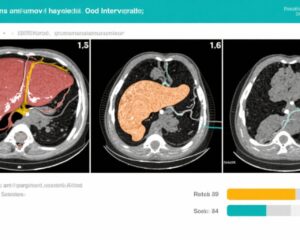Highlight
– A 4-week anti-inflammatory diet (ITIS diet) improved pain and overall health in knee osteoarthritis (OA) patients.
– Responders exhibited specific gut microbial shifts, particularly in Lachnospiraceae family taxa, correlated with pain reduction.
– Anti-inflammatory metabolites such as hydroxydecanoic acid derivatives and pyridoxine correlated with beneficial microbial changes.
– Structured microbiome-metabolome network interactions post-intervention were more pronounced in responders, suggesting targeted microbiome effects underlie clinical benefits.
Study Background and Disease Burden
Osteoarthritis (OA) is the most common degenerative joint disorder, affecting millions worldwide and causing debilitating pain and disability. Despite its high prevalence, therapeutic options largely center on symptom management, including analgesics and physical therapy, with no current disease-modifying treatments. Chronic inflammation within the joint and systemic low-grade inflammation are believed to contribute to OA pathogenesis and symptom severity. Emerging research points to the gut microbiome as a modulator of systemic inflammation and metabolite production that may influence joint health. Dietary interventions represent a promising, non-pharmacologic approach to modulate inflammation, pain, and quality of life in OA via the gut microbiome and metabolome, but clinical evidence remains sparse. The present study investigated whether an anti-inflammatory nutritional intervention could induce targeted microbial and metabolomic changes linked to symptomatic improvement in knee OA.
Study Design
This was a 4-week open-label pilot trial (ClinicalTrials.gov ID: NCT05559463) conducted at the University of California, San Diego, led by Monica Guma, to evaluate the effects of the ITIS anti-inflammatory diet in 20 patients with symptomatic knee OA. Inclusion criteria included an OA diagnosis confirmed clinically and radiographically. Primary endpoints were changes in clinical outcomes, assessed by the Western Ontario and McMaster Universities Osteoarthritis Index (WOMAC) pain scores and visual analog scale (VAS) for overall health. Responders were defined by a ≥30% reduction in WOMAC pain scores post-intervention. Secondary endpoints included gut and salivary microbiome composition analyzed by 16S rRNA sequencing and metabolomic profiling of salivary, stool, and plasma samples by mass spectrometry. Adherence to the diet was monitored through self-reports and food diaries.
Key Findings
The ITIS diet was well tolerated with a mean adherence rate of 66.2%. Clinically, the cohort experienced significant reductions in pain and improvements in overall health measured by VAS scores. Among the 20 participants, 8 (40%) were classified as responders, exhibiting at least a 30% reduction in pain.
Microbiome analysis revealed distinct compositional and functional differences between responders and non-responders post-diet. Taxonomic shifts were particularly evident within the family Lachnospiraceae, a group known for producing beneficial short-chain fatty acids (SCFAs) and modulating immune responses. Specifically, responders showed enrichment in Anaerostipes and Limivivens, both negatively correlated with pain scores, suggesting potential anti-inflammatory roles. Conversely, Oliverpabstia and Fusicatenibacter were depleted post-intervention in responders, indicating a selective microbial reshaping.
Metabolomic profiling identified strong correlations between these bacterial taxa and anti-inflammatory metabolites. Hydroxydecanoic acid derivatives, known to have anti-inflammatory effects, and pyridoxine (vitamin B6), critical in modulating immune function and neurotransmitter synthesis, were significantly associated with the enriched gut microbes.
Network analysis integrating microbiome and metabolome data demonstrated a more structured and selective pattern of interactions in responders after the dietary intervention, highlighting potential mechanistic links underlying clinical improvements. This suggests that targeted microbial shifts, rather than broad diversity changes, may be the key drivers of symptomatic relief.
Safety outcomes reported no significant adverse effects, supporting the feasibility of the ITIS diet as a supportive intervention in OA management.
Expert Commentary
This pioneering pilot study contributes valuable insights into the microbiome–diet–host axis in OA. The identification of Lachnospiraceae family members as pivotal players aligns with emerging evidence that SCFA-producing microbes modulate inflammatory milieu in chronic diseases. The observed biochemical associations with hydroxydecanoic acid derivatives and pyridoxine provide biological plausibility for the anti-inflammatory and analgesic effects. These findings underscore the importance of precision nutrition approaches tailored to individual microbial responses.
However, limitations include the small sample size, open-label design, and short duration, which restrict generalizability and causal inference. Larger randomized controlled trials with longitudinal follow-up are warranted to validate and extend these observations. Integration of metagenomic and functional analyses could further elucidate mechanistic pathways. Additionally, exploring the role of oral microbiome alterations on OA symptoms warrants attention given the salivary data.
Conclusion
This exploratory study highlights that a short-term anti-inflammatory dietary intervention can induce targeted gut microbial shifts and metabolomic changes associated with clinically meaningful pain reduction in knee osteoarthritis. Specifically, modulation of select Lachnospiraceae taxa and related anti-inflammatory metabolites suggests a promising avenue for personalized microbiome-informed nutritional strategies in OA management. While preliminary, these results pave the way for future research integrating diet, microbiome, and metabolomics to optimize therapeutic outcomes in OA—a disease with limited effective options. Incorporating such stratified approaches in clinical practice could revolutionize symptom control and quality of life for OA patients.
References
Sala-Climent M, Bu K, Coras R, Cedeno M, Zuffa S, Murillo-Saich J, Mannochio-Russo H, Allaband C, Hose MK, Quan A, Choi SI, Nguyen K, Golshan S, Blank RB, Holt T, Lane NE, Knight R, Scher J, Dorrestein P, Clemente J, Guma M. Targeted Microbial Shifts and Metabolite Profiles Were Associated with Clinical Response to an Anti-Inflammatory Diet in Osteoarthritis. Nutrients. 2025 Aug 22;17(17):2729. doi: 10.3390/nu17172729. PMID: 40944120; PMCID: PMC12430150.
Additional references:
– Huang Z, et al. Role of the Gut Microbiome in Osteoarthritis and Inflammation. Front Immunol. 2021.
– Loeser RF, et al. Osteoarthritis: a disease of the joint as an organ. Arthritis Rheum. 2012.
– Goldenberg DL. Osteoarthritis: an overview. In: Kelley’s Textbook of Rheumatology. 2020.
– Riva A, et al. Anti-inflammatory diets for osteoarthritis. Curr Opin Rheumatol. 2021.


